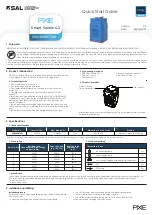
Guard Lock Safety-door Switch
D4JL
S
a
fe
ty D
o
o
r
Sw
it
c
h
e
s
P
recau
ti
on
s f
o
r
All Sa
fe
ty
Do
o
r
Switch
e
s
D4
NS
D4
GS-
N
D
4
BS
D4
G
L
D4
JL
D
4
NL
D4
BL
D4
NH
D
4
0
B
D4
NS-
SK0
1
D4
NS-
SK3
0
D4
J
L
-SK3
0
69
■
Precautions for Correct Use
Operation Key
• Be sure to use the designated Operation Key only. The Head has
been designed so that operation is not possible with a screwdriver
or other tools.
• Do not operate the Switch with anything other than the special
OMRON Operation Key, otherwise the Switch may break or the
safety of the system may not be maintained.
• Do not impose excessive force on the Operation Key inserted into
the Switch or drop the Switch with the Operation Key inserted,
otherwise the Operation Key may deform or break.
Securing the Door
If the Operation Key on the closed door is pulled outside the set zone
by force caused by vibration, the door's weight, or the door cushion
rubber, the Switch may be damaged.
Also, it may not be possible to unlock the Switch if weight is placed
on the Operation Key.
Secure the door with hooks so that it will remain within the set zone.
Switch Contacts
The Switch contacts can be used with either standard loads or
microloads. Once the contacts have been used to switch a load,
however, they cannot be used to switch smaller loads. The contact
surface will become rough and contact reliability may be reduced.
Release Key
• The release key is used to unlock the Switch in
case of emergency or if the power supply to the
Switch stops.
• If the release key setting is changed from LOCK
to UNLOCK using an appropriate tool, the lock
will be released and the safety door can be
opened (mechanical lock models only).
• After setting the release key to UNLOCK to, for example, change
the head direction or perform maintenance, be sure to return it to
the LOCK setting before resuming operation.
• The release key is set in the unlock position at the factory for the
D4JL-
@@@
A-
@
5 and D4JL-
@@@
A-
@
6 and in the lock position for
the D4JL-
@@@
G-
@
5 and D4JL-
@@@
A-
@
7-
@@
.
• If the release key is set to UNLOCK when the Switch is used for the
door of a machine room to ensure the safety of people performing
adjustment work inside, the door will not be locked when the door is
closed and no power will be supplied to the equipment.
• Do not use the release key to start or stop machines.
• The auxiliary lock must be released using the release key only by
authorized personnel.
• Do not impose a force exceeding 1 N·m on the release key screws.
The release key may be damaged and may not operate properly.
• To prevent the release key from being used by unauthorized
personnel, set it to LOCK and seal it with sealing wax.
Rear Release Button
• The rear release button is used for
emergency escapes when someone locks
a worker in the work area (hazardous
area).
• The door can be unlocked by pressing the
rear release button.
• After the rear release button is used to unlock the door, pull the
button out to restore it to its original state. If the button is left
pressed in, the door will not lock when the door is closed and power
will not be supplied to the equipment.
• Mount the Switch so that the rear release button can be operated
by a worker inside the work area (hazardous area).
Trapped Key
• The trapped key is released when
power is supplied to the solenoid.
Turn the trapped key to the UNLOCK
position and remove the key to
unlock the door. The door cannot be
unlocked solely by supplying power
to the solenoid. As long as a worker
has the trapped key with him when
he enters the work area (hazardous area), he cannot be locked
inside by another worker.
• Do not impose a force exceeding 1 N·m when operating the key.
Otherwise, the Switch may be damaged and may not operate
properly.
Weight applied
Dropped
Unlock
Trapped Key
Manual
release screw




































